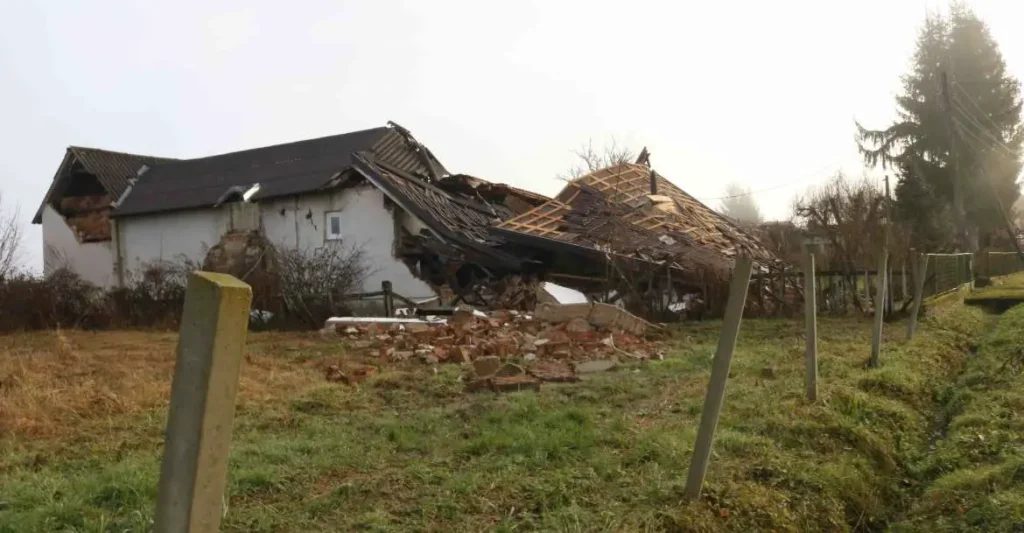As Poslovni Dnevnik/Suzana Varosanec writes, concrete moves on the implementation of the proper and organised reconstruction for citizens whose houses and buildings were damaged in the earthquake can be expected in just a few days, and after the amendments to the Reconstruction Act are published in the Official Gazette (Narodne Novine) early next week.
The beginning of February brings with it that long-awaited start of a major remediation work, followed by guarantees from government regulations that everyone will have the opportunity to have the same status, through a simple rights instruction depending on whether the building or family home received a green, yellow or red stamp following December’s tragic quake.
A ticket to the process is a request for a certain form of renovation that is submitted to the Ministry of Physical Planning, Construction and State Property.
According to the head of that department, Minister Darko Horvat, there is one unique address to which those affected apply – Republike Austrije 20 in Zagreb, more precisely to the Ministry of Physical Planning, Construction and State Property – electronically, by mail or directly in the offices which will be established locally in the field.
It has been said that people should not worry about who will ultimately pay or process the requests in question – because everything will be done by the state, strictly paying attention to quality and that there is no so-called grey economy being born out of the event.
“It’s important that the work is designed by authorised designers and the works are performed by authorised contractors”, Horvat pointed out, explaining that if a family house received a red sticker, the request for renovation can be submitted by the owner or co-owners, as well as by building managers.
However, the existing e-Permit (e-Dozvola) system won’t be suitable for post-earthquake reconstruction procedures, but Horvat’s department has confirmed that a separate new system called e-Reconstruction is now being developed.
The new e-Reconstruction platform will make the whole process – from receiving requests to the implementation of the renovation – transparent, and they say submitting requests will be faster and easier. Its development is in now in its final phase and full functionality is expected soon. It will enable the electronic submission of applications, as well as transparent monitoring of the entire process, but after that, it seems that significant differences will begin to be seen.
Although the e-Reconstruction platform hasn’t yet been seen in operational terms, according to the President of the Zagreb Architects Association and the Association of HGK Architects, Tihomil Matkovic, it would be good to keep it in mind as a good solution due to simplification of procedures and wider needs, especially regarding the construction project defined by the general regulation of the Construction Act.
“In the case when the state is doing a large construction project, the simplification of the procedure is required in order to achieve speed, unlike the approach to any regular investor who has a large and significant project but no possibility to speed up the procedure.
In the event of a major renovation, we have a period of 18 months to use EU funds in the amount of 683 million euros, which has already been running for about a month.
However, as with any investment when a private investor invests, it is also bound by the conditions regarding the disposal of those funds, so this element should be taken into account for further improvements,” suggested Matkovic.
The profession considers the e-Permit system to be good, but that it also represents a brand new way of preparing documentation.
As many claim, the processes behind this system haven’t been improved. The consequence is that a whole range of clerks are still involved, and if each one day is late, the total of a lot of time is reported to pass in which, they claim, a number of people have to give their consent.
The Law on Reconstruction, Matkovic pointed out, narrowed down all processes to the responsibility of the designer, auditor and supervisor, emphasising their responsibility for implementation. A large number of requests for the reconstruction of earthquake-damaged private houses and residential and commercial buildings are expected to be accepted at a fast pace.
As things currently stand, after the department decides on the justification of the request, the state enters the scene and based on a specific request and decision will begin to carry out reconstruction, both through the payment of fees and the removal of buildings, followed by construction. These decisions will be forwarded to the implementing body – the Zagreb Reconstruction Fund, and as its interim director Damir Vandjelic points out, they’re expected to be fully prepared for it all.
The fund is functioning, says Vandjelic, and it’s ready for this. The Board of Directors of the Fund met yesterday and approved the start of public procurement. It involves a set of decisions which, with the approval of the Fund’s budget, concern the ordinance on public procurement, with a plan and accompanying documentation so that public procurement can be carried out.
Again, depending on the state’s decisions on which building renovation projects it will embark on, the Fund is going to issue a public call to designers to apply. The designers can expect this during the next week, and their numbers and level of interest show that it will not be a ”bottleneck” situation, claimed the president of the Croatian Chamber of Architects, Rajka Bunjevac.
However, he warned that a post-war reconstruction mistake shouldn’t have occurred when dumping prices did. Therefore, it will be necessary to distribute the work well by assessing the competence to perform the work within the agreed deadlines. For the part concerning the designers, he says, through the first programme of measures, optimal prices have been attributed.
“We warned that it wouldn’t be good for someone to get a large amount of work just because they offered a low price, and that it’s important who is doing the work because their quality can jeopardise the project.
The right solution is the additional criteria for evaluating the offer with high scores, such as experience, references, size and number of employees, as well as that what is valid for the design must be valid for choosing who will do the professional supervision and the contractor. Owners can, in addition to their own co-financing, request the development of a higher level of the project.
For the latest travel info, bookmark our main travel info article, which is updated daily.
Read the Croatian Travel Update in your language – now available in 24 languages.
Join the Total Croatia Travel INFO Viber community.










